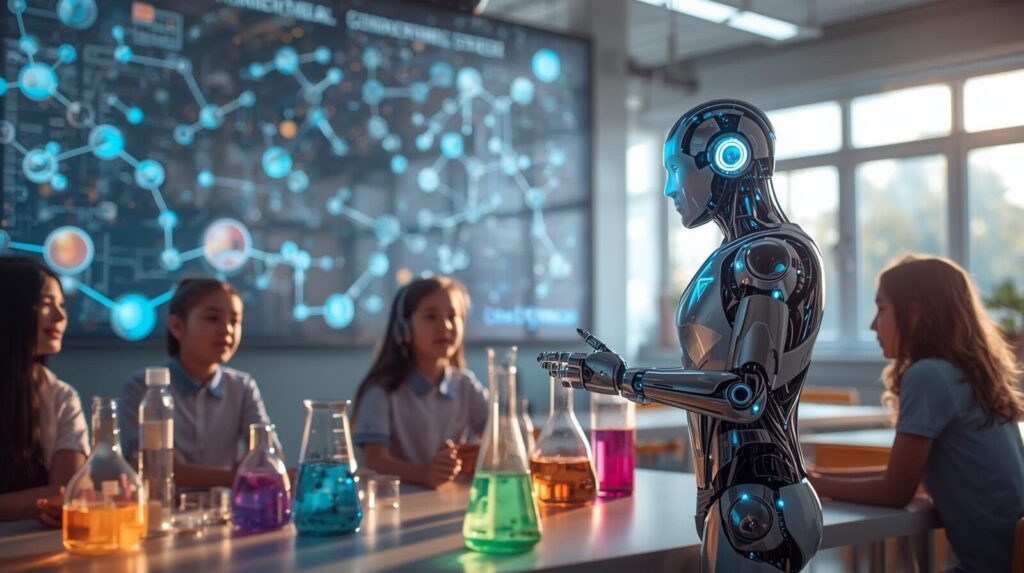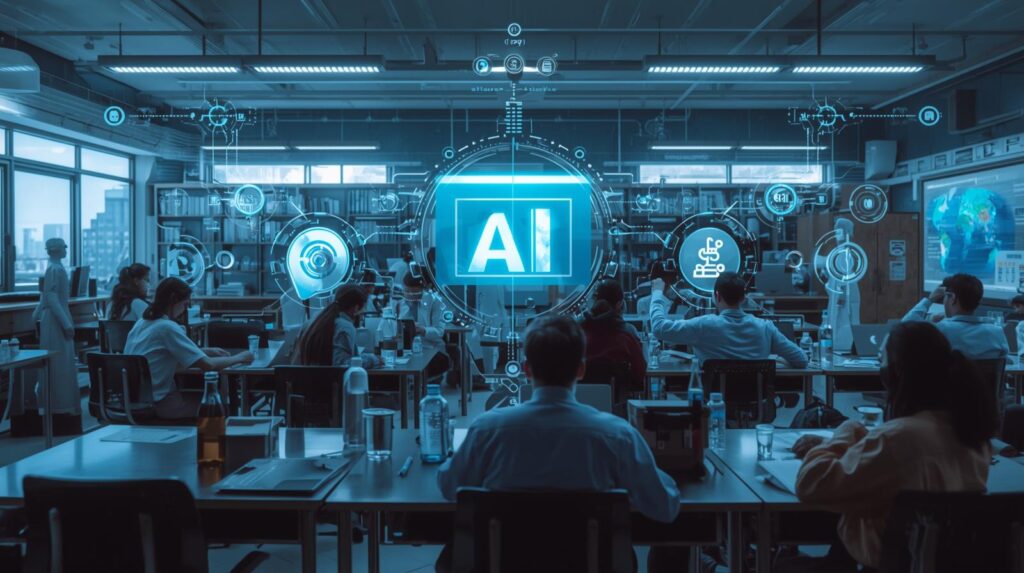AI in Science Classroom: The White House Bold New Education Challenge
Imagine a science classroom where students use artificial intelligence to predict weather patterns, analyze fossils, or model ecosystems—all while learning the skills to shape the future. That’s the vision behind the White House’s bold new education initiative, launched in April 2025, to bring AI into K-12 schools. This effort, started by President Trump’s order, wants to make AI an important part of learning, especially in science. It’s not just about tech—it’s about preparing kids to solve real-world problems like climate change or resource management.
What Is the White House AI Education Challenge?
The White House kicked off this effort with a clear goal: ensure America’s kids are ready for an AI-driven world. The Executive Order, signed on April 23, 2025, sets out to weave AI into education, boost teacher training, and spark early interest in AI concepts. At its heart is the Presidential Artificial Intelligence Challenge, a nationwide competition encouraging students and educators to create AI-based solutions for community issues, like improving water quality or predicting natural disasters.
This challenge isn’t a one-size-fits-all contest. It includes different age groups, regions, and themes to make it inclusive and exciting. Picture an 8th grader in Texas using AI to study local soil erosion, or a high school teacher in California designing an AI lesson to explore ocean currents. The challenge celebrates creativity and problem-solving, fostering collaboration between schools, tech companies, and communities. It’s set to launch within a year, with plans due by late July 2025, and it’s backed by federal agencies and private partners like Microsoft, Google, and OpenAI.
The broader initiative goes beyond the challenge. It calls for public-private partnerships to create online resources for K-12 AI education, focusing on foundational AI literacy and critical thinking. These materials must be ready for classrooms within 180 days of partnership announcements. The White House Task Force on Artificial Intelligence Education, chaired by the Director of the Office of Science and Technology Policy, oversees it all, with members from departments like Education, Labor, and Agriculture.
Why AI in Science Classrooms Matters
Science classrooms are perfect for AI because they’re all about asking questions, testing ideas, and solving problems. AI can make this hands-on and fun. For example, students can use AI tools to analyze data from experiments, like tracking temperature changes to study climate or mapping earthquake patterns. These tools don’t just crunch numbers—they help kids think like scientists, spotting trends and making predictions.

AI also connects to real-world issues. Science classes often cover topics like ecosystems, weather, or geology, and AI can model complex systems, like how deforestation affects carbon levels. With the world facing challenges like rising sea levels or extreme weather, AI equips students to tackle these problems. It’s not just theory—it’s about making a difference, whether they’re in 6th grade or high school.
Plus, AI skills are in demand. Jobs in science, tech, and engineering are growing, and knowing AI gives students a head start. By 2030, 70% of AI-related skills are expected to shift, so early exposure is key. The White House’s push ensures kids aren’t just users of tech but creators, ready for careers in fields like environmental science or data analysis.
How AI Is Being Integrated into Science Education
So, how does this work in a science classroom? The initiative focuses on three big areas: teacher training, student projects, and accessible resources. Let’s break it down.
Teacher Training: Empowering Educators
Teachers are the backbone of this plan. The Executive Order directs the Department of Education to prioritize AI in teacher training grants under laws like the Elementary and Secondary Education Act. Within 120 days of the order, programs must focus on using AI to cut administrative tasks, improve evaluations, and integrate AI into subjects like science. For example, a biology teacher might learn to use AI to simulate cell growth, making lessons interactive.
The National Science Foundation (NSF) is also stepping up, prioritizing research on AI in education and creating teacher workshops. These help educators use AI tools, like software that analyzes lab results or apps that visualize chemical reactions. The Department of Agriculture even joins in, using programs like 4-H to teach AI in rural science classes, maybe showing kids how to monitor soil health with AI.
Microsoft’s $1.25 million in educator grants, announced in September 2025, will reward teachers who lead in AI-powered science lessons. Free LinkedIn Learning courses are also available, guiding teachers from basic AI concepts to advanced skills. This ensures educators aren’t just teaching AI—they’re confident using it to make science come alive.
Student Projects: The Presidential AI Challenge
The Presidential AI Challenge is the star of the show. Students might design an AI model to predict local flooding risks in a geology unit or use machine learning to classify plant species in biology. These projects aren’t just for tech whizzes—kids of all skill levels can join, using simple AI platforms tailored for schools. The challenge spans regions and topics, so a student in Florida might focus on hurricanes, while one in Iowa tackles soil conservation.
This hands-on approach makes science exciting. Imagine a middle schooler using AI to analyze air quality data from their town, presenting findings to their class. It’s not just homework—it’s solving real problems. The challenge also offers prizes and recognition, motivating kids to dive into science and tech.
Accessible Resources: Partnerships for All
The initiative leans on partnerships with tech giants, universities, and nonprofits to create free online resources. Over 60 organizations, including Microsoft, Google, and McGraw Hill, signed the White House’s Pledge to America’s Youth in June 2025, committing to deliver AI curricula, tools, and training. These resources focus on teaching AI basics, like how algorithms work, and critical thinking, like spotting bias in AI outputs. They’ll be ready for classrooms by early 2026, ensuring even small schools can access them.
For science classes, this might mean free apps to model ecosystems or analyze weather data. Nonprofits like the National Applied AI Consortium are also involved, offering tools for hands-on experiments. This levels the playing field, giving rural and underserved schools the same shot at cutting-edge tech.
Benefits for Science Classrooms
Bringing AI into science education has some big wins:
- Hands-On Learning: AI lets students experiment with real data, like tracking carbon emissions or modeling volcanic activity. It makes abstract concepts, like plate tectonics, visual and interactive.
- Real-World Impact: Projects tied to local issues, like water pollution or deforestation, show kids their work matters. A student in a coastal town might use AI to study coral reef health, connecting science to their community.
- Skill-Building: AI teaches critical thinking, coding basics, and data analysis—skills for science careers and beyond. Students learn to question AI results, ensuring they’re not just trusting tech blindly.
- Engagement: Interactive tools make science fun. Instead of memorizing facts, kids can explore simulations, like how AI predicts weather shifts or earthquake risks.
Challenges and Concerns
It’s not all smooth sailing. Some worry about rushing AI into classrooms without enough planning. Teachers are already stretched thin—adding AI training could overwhelm them. Schools with tight budgets might struggle to access high-end tools, even with free resources. There’s also the risk of over-relying on AI, sidelining the human connection between teachers and students. Experts like Pasi Sahlberg emphasize that trust and relationships must stay central, not algorithms.
Another concern is equity. Will rural or low-income schools get the same support as urban ones? The initiative aims to address this through partnerships, but success depends on follow-through. There’s also the question of data privacy—AI tools must protect student information. Critics note the Trump administration rolled back some AI regulations, raising fears about unchecked tech in schools.

Skeptics, including some educators, worry the push prioritizes tech companies’ interests over pedagogy. Groups like Moms for Liberty are involved, which sparks debate about whether politics, not education, is driving parts of the plan. Teachers’ voices need to be heard to ensure AI fits real classroom needs, not just corporate agendas.
The Bigger Picture
This initiative is part of a larger goal to keep America leading in AI. By teaching kids early, the White House hopes to build a workforce ready for an AI-driven economy. Science classrooms are a natural fit, as AI can enhance experiments and spark curiosity about the natural world. First Lady Melania Trump, a champion of the effort, launched the challenge in August 2025, urging students to “unleash their imagination” in science and beyond.
The plan also ties to workforce development. The Department of Labor is expanding AI-related apprenticeships, letting high schoolers explore science careers through programs like dual enrollment. This connects classroom AI projects to real jobs, like analyzing environmental data or developing green tech.
What’s Next?
The White House’s plan is ambitious, but it’s just starting. By mid-2026, we’ll see the first wave of resources and challenge results. Schools will need support to train teachers and integrate tools without losing the heart of education—human connection. Students, meanwhile, get a chance to shine, using AI to explore science in ways that were once just dreams.
For an 8th grader, this is exciting. Imagine using AI to study the stars, predict floods, or save endangered species. The White House’s bold challenge is about giving you the tools to ask big questions and find answers that help the world. Whether you’re a future scientist or just curious, AI in the science classroom is opening doors to a new era of discovery.
